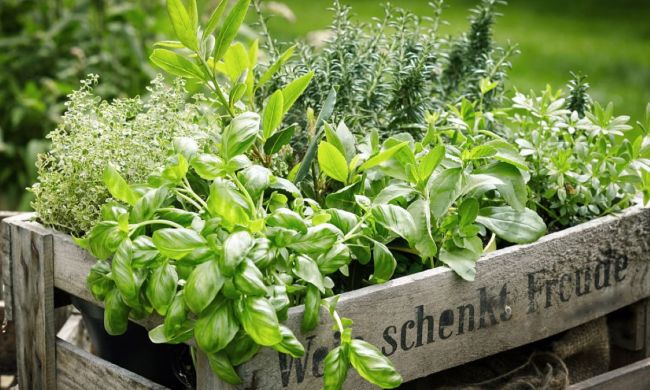In the culinary world, Mexican oregano and oregano can sometimes be confused for one another. While browsing the grocery store, you may toss one in your cart when you’re working with a recipe that calls for the other herb — it’s an easy mistake! At the end of the day, your recipe won’t be totally ruined if you use them interchangeably, but these flavorful and easygoing herbs do bring different things to the table. If you’re wondering what makes them distinct and why the nuances matter, keep reading ahead.

Mexican oregano vs. oregano
Is oregano the same as Mexican oregano? Not quite. Though they look similar with their flat leaves and purple flowers, Mexican oregano (Lippia graveolens) and oregano (Origanum vulgare) are different plants altogether. They might, on the surface, look similar, however, and they actually share flavor and aroma compounds called “terpenes.” Both can also be grown as either container-bound herbs indoors or groundcover herbs outdoors. But they do differ in how they look and grow.
A closer look may help you distinguish details between these herbs. Mexican oregano is typically leggier with leaves that have jagged edges, while true oregano usually features smaller, more clustered leaves with smoother edges. In terms of origin, Mexican oregano comes from Mexico and parts of South America, while true oregano, or European or Mediterranean oregano, is native to parts of southwestern Europe and Asia. In your garden, Mexican oregano will spread six feet and shoot up six feet in height, so it appreciates space to grow. True oregano, on the other hand, spreads around two feet and grows 1.5 feet tall.
Mexican oregano and true oregano in dishes
Mexican oregano is part of the verbena family, featuring a floral and citrusy flavor. When it comes to culinary uses, it’s excellent for Latin dishes, pairing especially well with chilis in chili, salsa, and adobo. It’s sometimes brewed as tea, which is why it’s sometimes called té de pais, or “country tea.” Mediterranean oregano, on the other hand, is part of the origanum family and is more closely related to mint. Featuring a sweet and peppery flavor, it often goes on pizza and pasta as extra garnish.
Can you substitute oregano for Mexican oregano?
One ingredient won’t make or break a recipe, but oregano and Mexican oregano offer different flavors. You can substitute oregano for Mexican oregano, but the taste may be different from what you’re looking for. Mexican oregano, in fact, tends to be stronger and earthier, so less is more if you’re substituting it for traditional oregano. Instead of true oregano, marjoram and lemon verbena will give you more of the citrus note you may be looking for.

How to grow Mexican oregano and oregano
Although different in flavor, Mexican oregano and oregano share relatively similar care requirements. Here’s what you need to know to keep each thriving throughout the growing season.
How to care for Mexican oregano
Mexican oregano is a perennial shrub that does well in partial shade or full sun in well-draining soil. It can be grown from seeds, cuttings, or root division, so sourcing it isn’t difficult. While it appreciates deep watering in well-draining soil, it’s also relatively drought tolerant. Blooms appear in the summer, which is when you should start cutting back on the foliage — which you can dry out to use in your favorite recipes! Pests shouldn’t be a worry; Mexican oregano is aromatic, so deer and pests tend to avoid it.
How to care for oregano
Oregano thrives in full sun in well-draining soil. You’ll have the best luck growing plants from cuttings or divided roots when the temperatures are above 70 degrees Fahrenheit in spring or fall. As with Mexican oregano, it can resist bouts of drought — in fact, overwatering may actually cause root rot. Oregano appreciates regular trimming to branch out, so you can cut and use it throughout the growing season. Like Mexican oregano, oregano is relatively pest resistant, although you may occasionally encounter spider mites or aphids.
Where can you buy Mexican oregano?
If you’re looking for Mediterranean or Mexican oregano to use in a pinch, you can search for them at your supermarket. Mediterranean oregano is often a staple in grocery stores, but Mexican oregano may be harder to find. You can usually find Mexican oregano in dry form (as it’s often used) at Latin markets. If you can’t get Mexican oregano at a local supermarket, you can always find it online and have it shipped right to your door.
Sharing similar appearances and some flavor notes, oregano and Mexican oregano actually feature differences that make each suitable for specific dishes. Your sweet, anise-flavored true oregano will kick up your pizza and pasta, while citrusy, earthy Mexican oregano will brighten up chili and salsa. At the end of the day, both are prolific growers that are easy to care for. And if you can’t grow them in time for your recipe, you’ll often be able to find them at your grocery store or online in a pinch!



